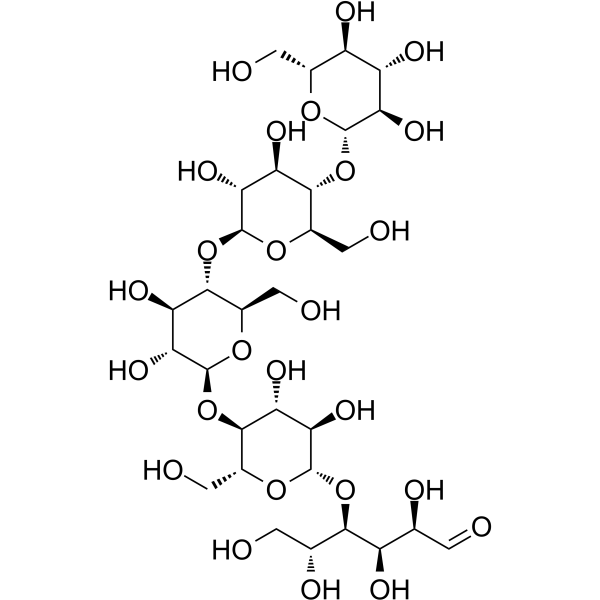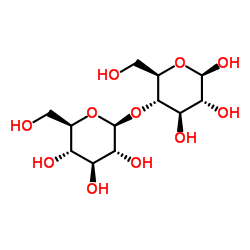Cellopentaose

Cellopentaose structure
|
Common Name | Cellopentaose | ||
|---|---|---|---|---|
| CAS Number | 2240-27-9 | Molecular Weight | 828.718 | |
| Density | 1.8±0.1 g/cm3 | Boiling Point | 1253.2±65.0 °C at 760 mmHg | |
| Molecular Formula | C30H52O26 | Melting Point | 245-268ºC | |
| MSDS | Chinese USA | Flash Point | 385.5±27.8 °C | |
Use of CellopentaoseCellopentaose is a penta oligosaccharide of cellulose[1]. |
| Name | D-Cellopentaose |
|---|---|
| Synonym | More Synonyms |
| Description | Cellopentaose is a penta oligosaccharide of cellulose[1]. |
|---|---|
| Related Catalog | |
| References |
| Density | 1.8±0.1 g/cm3 |
|---|---|
| Boiling Point | 1253.2±65.0 °C at 760 mmHg |
| Melting Point | 245-268ºC |
| Molecular Formula | C30H52O26 |
| Molecular Weight | 828.718 |
| Flash Point | 385.5±27.8 °C |
| Exact Mass | 828.274658 |
| PSA | 434.82000 |
| LogP | -6.20 |
| Appearance of Characters | Powder | White to off-white |
| Vapour Pressure | 0.0±0.6 mmHg at 25°C |
| Index of Refraction | 1.683 |
| Storage condition | 2-8°C |
| Personal Protective Equipment | Eyeshields;Gloves;type N95 (US);type P1 (EN143) respirator filter |
|---|---|
| RIDADR | NONH for all modes of transport |
| WGK Germany | 3 |
| Precursor 1 | |
|---|---|
| DownStream 0 | |
|
Capillary electrophoresis fingerprinting of 8-aminopyrene-1,3,6-trisulfonate derivatized nitrocellulose after partial acid depolymerization.
J. Chromatogr. A. 1387 , 134-43, (2015) Fine characterization of nitrocellulose (NC) remains a challenge, especially in forensic analysis, and a strategy consisting in obtaining representative fingerprints by a separation technique, as for ... |
|
|
Combining free and aggregated cellulolytic systems in the cellulosome-producing bacterium Ruminiclostridium cellulolyticum.
Biotechnol. Biofuels 8 , 114, (2015) Ruminiclostridium cellulolyticum and Lachnoclostridium phytofermentans (formerly known as Clostridium cellulolyticum and Clostridium phytofermentans, respectively) are anaerobic bacteria that develope... |
|
|
Multifunctional cellulolytic auxiliary activity protein HcAA10-2 from Hahella chejuensis enhances enzymatic hydrolysis of crystalline cellulose.
Appl. Microbiol. Biotechnol. 99(7) , 3041-55, (2015) The modular auxiliary activity (AA) family of proteins is believed to cause amorphogenesis in addition to oxidative cleavage of crystalline cellulose although the supporting evidence is limited. HcAA1... |
| 4-ethoxypyrimidin-2-one |
| 4-Aethoxy-2-keto-1,2-dihydropyrimidin |
| β-D-Glucopyranosyl-(1->4)-β-D-glucopyranosyl-(1->4)-β-D-glucopyranosyl-(1->4)-β-D-glucopyranosyl-(1->4)-D-glucose |
| D-Glucose, O-β-D-glucopyranosyl-(1->;4)-O-β-D-glucopyranosyl-(1->4)-O-β-D-glucopyranosyl-(1->4)-O-β-D-glucopyranosyl-(1->4)- |
| O4-ethyluracil |
| 4-ethoxy-1H-pyrimidin-2-one |
| cellopentaose |
| 4-ethoxy-2-pyrimidone |
| Glcβ(1-4)Glcβ(1-4)Glcβ(1-4)Glcβ(1-4)Glc |
| 4-Aethoxy-1H-pyrimidin-2-on |
| 4-ethoxypyrimidin-2-ol |
| 4-Ethoxy-2-hydroxypyrimidine |
| 4-ethoxy-2-pyrimidinol |
 CAS#:528-50-7
CAS#:528-50-7
